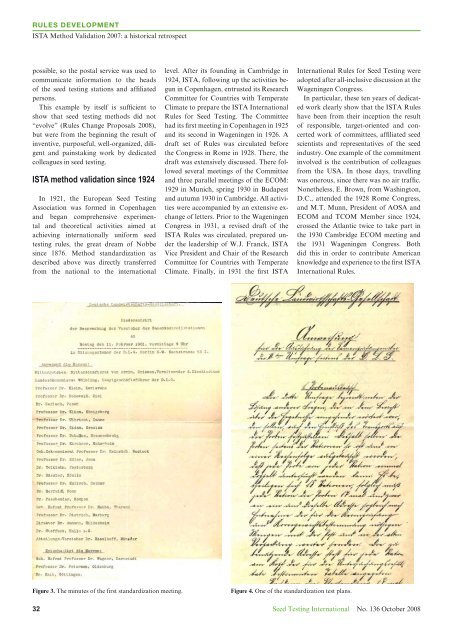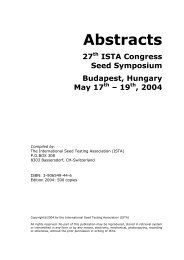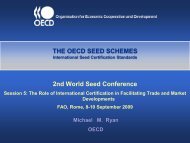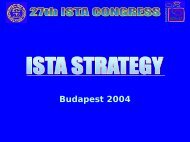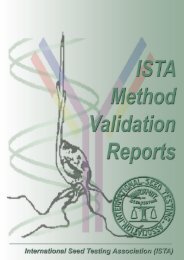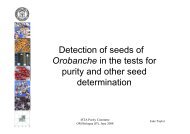(ISTA News Bulletin) No. 136, October 2008 - International Seed ...
(ISTA News Bulletin) No. 136, October 2008 - International Seed ...
(ISTA News Bulletin) No. 136, October 2008 - International Seed ...
You also want an ePaper? Increase the reach of your titles
YUMPU automatically turns print PDFs into web optimized ePapers that Google loves.
Rules Development<br />
<strong>ISTA</strong> Method Validation 2007: a historical retrospect<br />
possible, so the postal service was used to<br />
communicate information to the heads<br />
of the seed testing stations and affiliated<br />
persons.<br />
This example by itself is sufficient to<br />
show that seed testing methods did not<br />
“evolve” (Rules Change Proposals <strong>2008</strong>),<br />
but were from the beginning the result of<br />
inventive, purposeful, well-organized, diligent<br />
and painstaking work by dedicated<br />
colleagues in seed testing.<br />
<strong>ISTA</strong> method validation since 1924<br />
In 1921, the European <strong>Seed</strong> Testing<br />
Association was formed in Copenhagen<br />
and began comprehensive experimental<br />
and theoretical activities aimed at<br />
achieving internationally uniform seed<br />
testing rules, the great dream of <strong>No</strong>bbe<br />
since 1876. Method standardization as<br />
described above was directly transferred<br />
from the national to the international<br />
level. After its founding in Cambridge in<br />
1924, <strong>ISTA</strong>, following up the activities begun<br />
in Copenhagen, entrusted its Research<br />
Committee for Countries with Temperate<br />
Climate to prepare the <strong>ISTA</strong> <strong>International</strong><br />
Rules for <strong>Seed</strong> Testing. The Committee<br />
had its first meeting in Copenhagen in 1925<br />
and its second in Wageningen in 1926. A<br />
draft set of Rules was circulated before<br />
the Congress in Rome in 1928. There, the<br />
draft was extensively discussed. There followed<br />
several meetings of the Committee<br />
and three parallel meetings of the ECOM:<br />
1929 in Munich, spring 1930 in Budapest<br />
and autumn 1930 in Cambridge. All activities<br />
were accompanied by an extensive exchange<br />
of letters. Prior to the Wageningen<br />
Congress in 1931, a revised draft of the<br />
<strong>ISTA</strong> Rules was circulated, prepared under<br />
the leadership of W.J. Franck, <strong>ISTA</strong><br />
Vice President and Chair of the Research<br />
Committee for Countries with Temperate<br />
Climate. Finally, in 1931 the first <strong>ISTA</strong><br />
<strong>International</strong> Rules for <strong>Seed</strong> Testing were<br />
adopted after all-inclusive discussion at the<br />
Wageningen Congress.<br />
In particular, these ten years of dedicated<br />
work clearly show that the <strong>ISTA</strong> Rules<br />
have been from their inception the result<br />
of responsible, target-oriented and concerted<br />
work of committees, affiliated seed<br />
scientists and representatives of the seed<br />
industry. One example of the commitment<br />
involved is the contribution of colleagues<br />
from the USA. In those days, travelling<br />
was onerous, since there was no air traffic.<br />
<strong>No</strong>netheless, E. Brown, from Washington,<br />
D.C., attended the 1928 Rome Congress,<br />
and M.T. Munn, President of AOSA and<br />
ECOM and TCOM Member since 1924,<br />
crossed the Atlantic twice to take part in<br />
the 1930 Cambridge ECOM meeting and<br />
the 1931 Wageningen Congress. Both<br />
did this in order to contribute American<br />
knowledge and experience to the first <strong>ISTA</strong><br />
<strong>International</strong> Rules.<br />
Figure 3. The minutes of the first standardization meeting.<br />
32<br />
Figure 4. One of the standardization test plans.<br />
<strong>Seed</strong> Testing <strong>International</strong> <strong>No</strong>. <strong>136</strong> <strong>October</strong> <strong>2008</strong>


